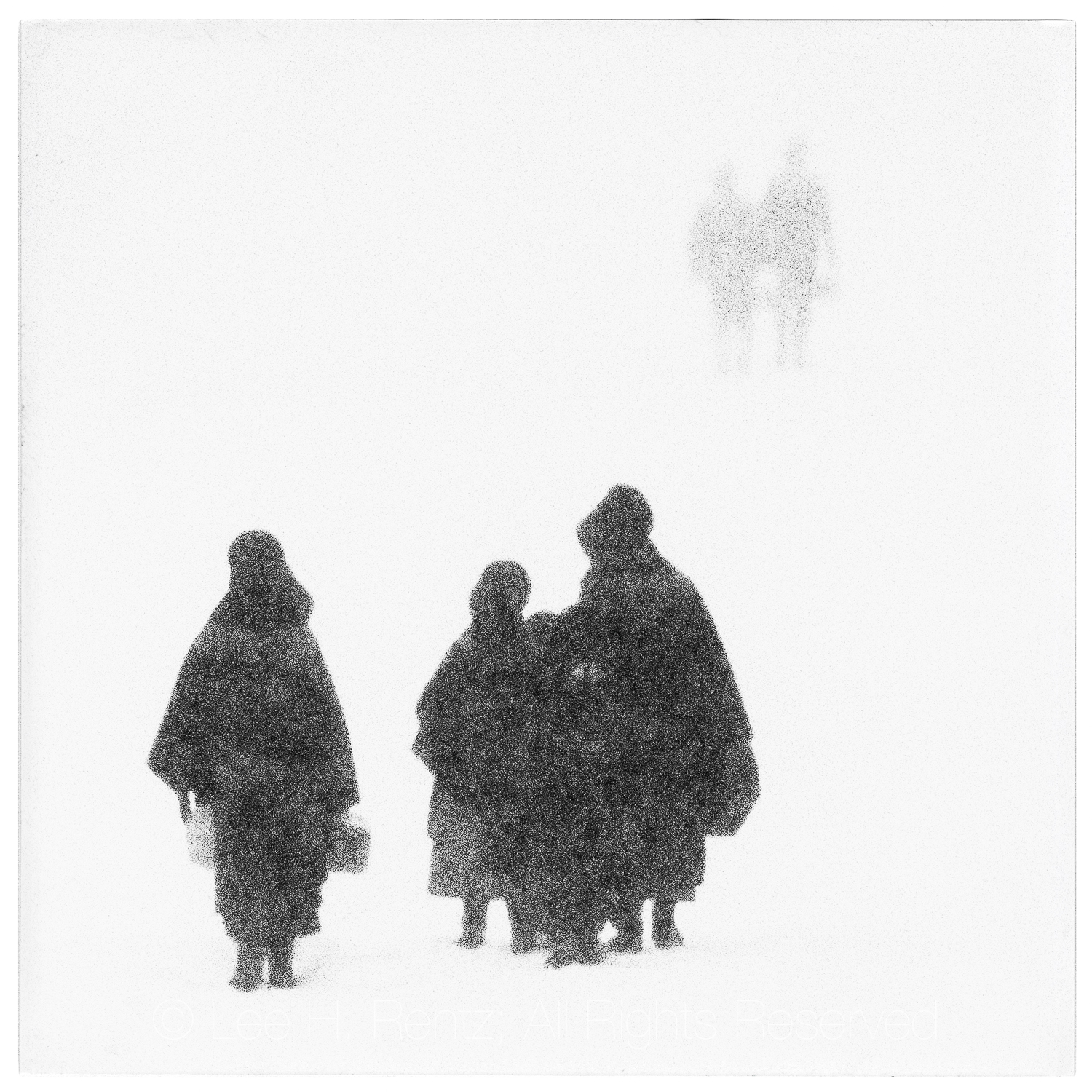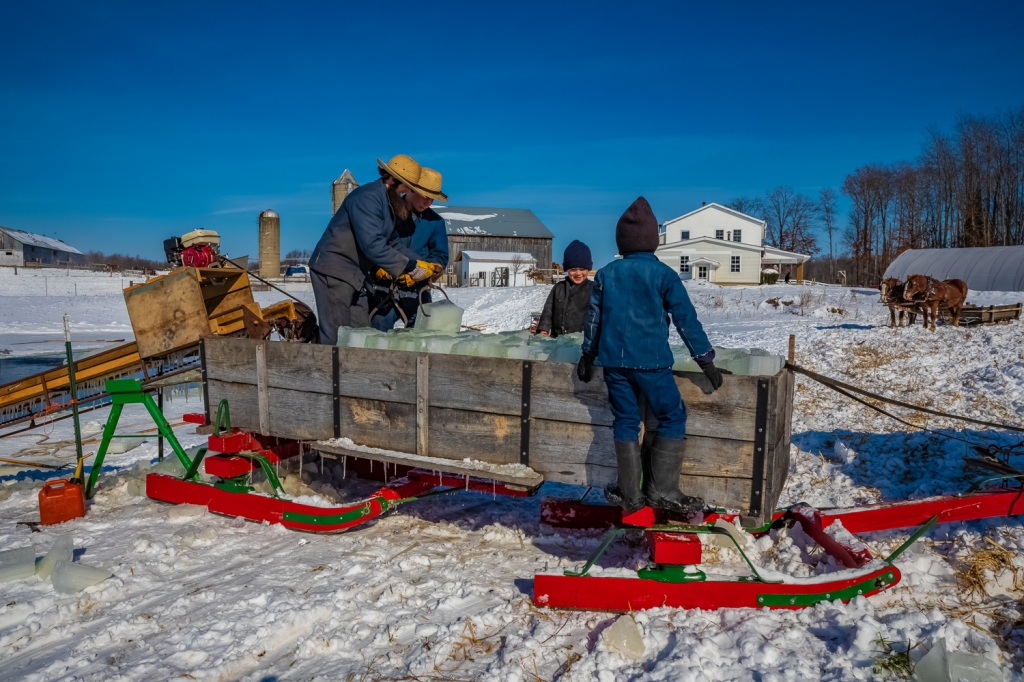
Today was a gift from the universe.
I had an instinct that today (4 February 2023) could be the day when Amish farmers cut ice from their ponds to fill their icehouses after the cold snap of the last week, a warming weather trend ahead, and tomorrow the sabbath. We drove out into the Amish community this morning, and almost immediately saw a freight wagon loaded with ice. We drove on, and found another farm where wagons were lined up in front of a pond, where men wearing straw hats were cutting ice.
We parked at a respectful distance, watching and discretely photographing for about an hour. Then an Amish man came walking up to where we were parked along the road. He was a young man and kindly asked if we had ever seen Amish ice cutting before. We said “only at a distance,” and he invited us to come down closer to see it. I asked if it was okay if I took pictures, and he said “Yes. Just not too close.”
So we went down near to where ten men and teen boys worked as a team to cut the ice with a gas-powered circular saw and load six sleighs and wagons, each drawn by two draft horses. Assorted young boys all wearing matching dark knit hats and a dog completed the perfect rural scene.
We got to talking with the young man and his little brother, and he invited us to have a meal with them. So we sat down for a noontime dinner with the father, mother, 11 of their 13 children, and a couple of young men from a nearby farm. After a hearty meal, they went back to ice cutting and me to my pictures. Magic happens.
As I said, a gift from the universe to two shy people.
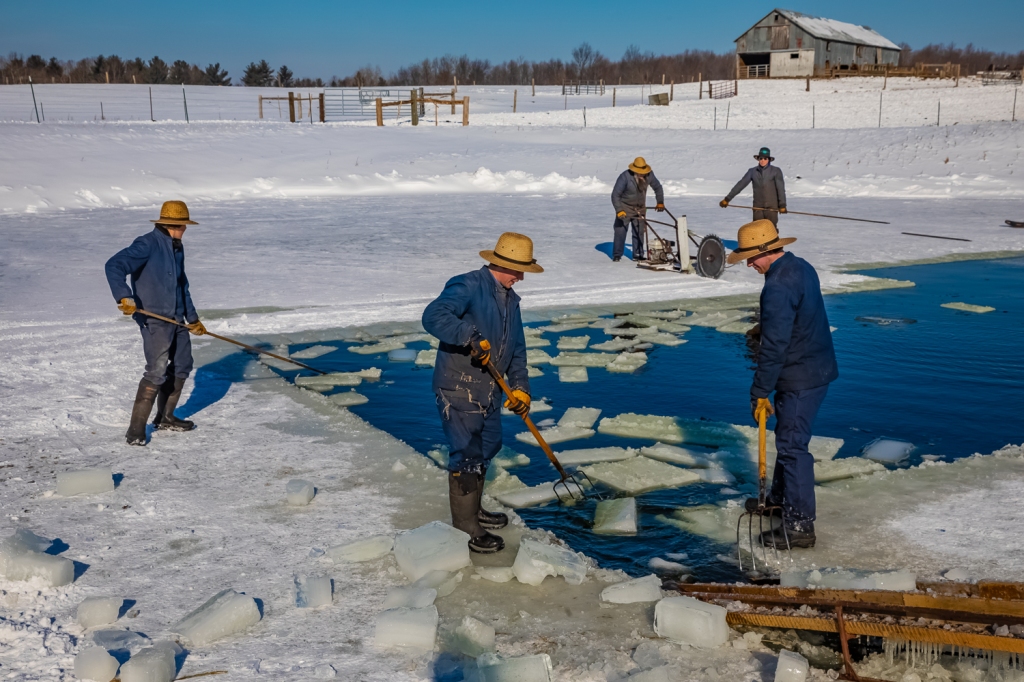
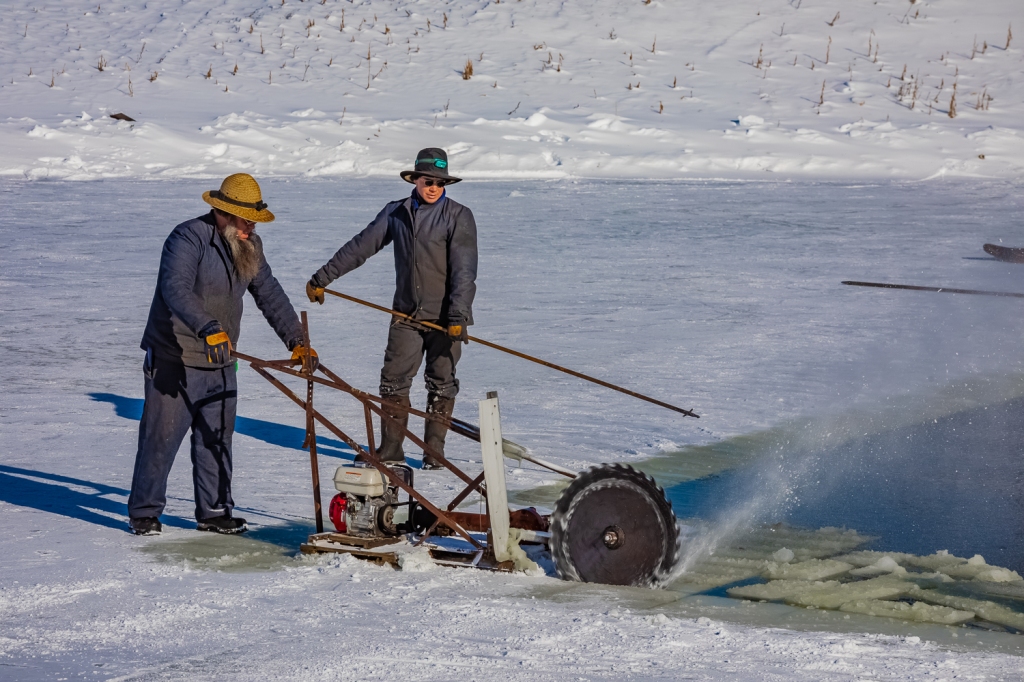
Notes from our conversations with an Amish family:
Since most English (the word used by the Amish for non-Amish people like us) know little about the Amish, I will tell you about our discussions with this kind and generous family. My wife Karen and I talked to the farmer and his wife, as well as with some of their sons, both before and during the meal, learning a bit about their lives. They have 13 children, of whom 11 still live at home. The other two are the older adult children, both married, with the son living on a small farm in an Amish community in Illinois and the daughter at a farm nearby. The children were spaced quite regularly in age, with the youngest son being two. Of their children, nine were boys and four girls. The eldest daughter still living at home now teaches at an Amish one-room schoolhouse eight miles from their house.
The Amish have not been here for as long as they’ve been in Pennsylvania. My parents moved to the area in 1980, when they built the house that we now own. A couple of years after they moved in, one of their friends said that Amish were starting to buy up the surrounding farms, and that the land was about to blossom with new activity and a flourishing of crops. The farmer in my story moved here when he was a boy, in that first wave of Amish. He said that the price of the land was good. The families here have done well, with what appear to be prosperous and beautiful farms.

The family has an extensive summer garden, where last year they planted and harvested over five acres of pumpkins and winter squash. Some of their crops are sold at a local open-air produce auction, which we’ve driven past at times when it wasn’t open. It is like a farmer’s market, open only prescribed days each month. At this time of year firewood and hay are for sale, but in summer and fall there would be a wonderful variety of produce and flowers. I remember last year seeing a horse-drawn farm wagon with clear plastic sheeting forming a greenhouse structure over the wagon. Inside there were colorful hanging baskets of flowers protected from wind by the plastic. I think the flowers were headed to the farm auction. Here is an article about this particular auction facility: Stanwood Produce Auction
The young man who initially invited us down to see the ice cutting is 18 years old, friendly, and personable. He talked about the economics of the farm. They have a sawmill, as many of the local Amish farmers do, where loggers bring loads of softwood logs. The farmer brings the logs one by one into the mill, where they are sawn into 2×4’s and other dimensional lumber that is sold to a pallet maker south of Grand Rapids; that factory is perhaps 80 miles away, so the wood has to be transported by truck to the buyer. I’m sure the sawmill is a major source of income for the family. I mentioned that there has been a great increase in the number of Amish farms in our area with sawmills and wondered about the competition. The father said that so far it wasn’t a problem, that there was enough demand and that some of the sawmills were for softwood and others for hardwood. I think they also have a maple sugaring operation, as do many of the local families.
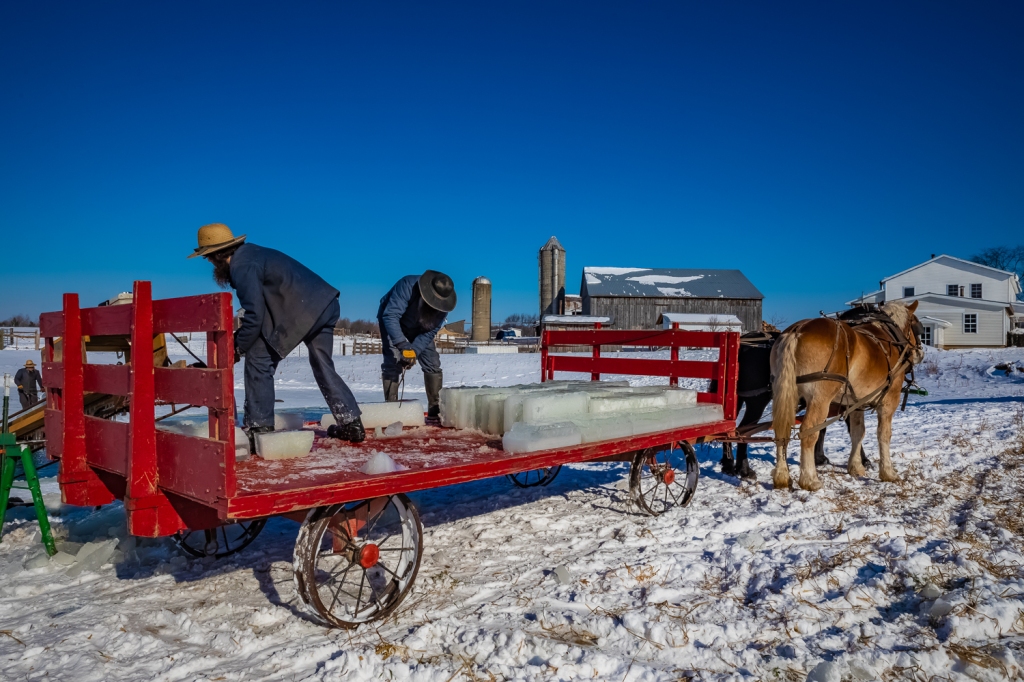
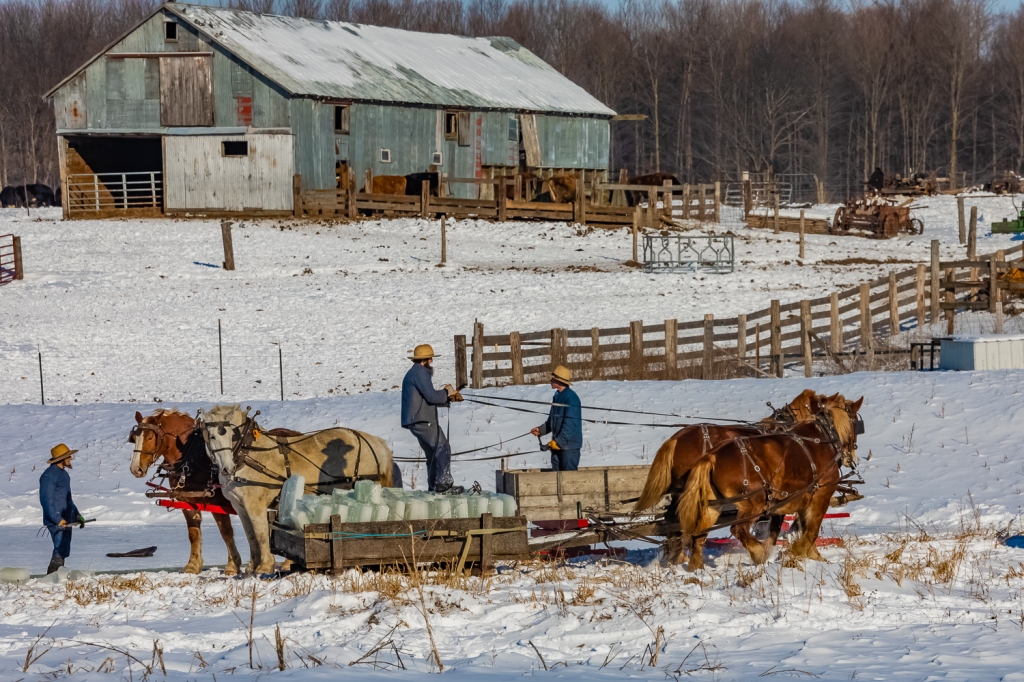
The farmer would also grow corn and hay for feeding the livestock. In early spring he would use a horse-drawn plow (on local farms we’ve seen up to six draft horses pulling a plow!). Horses would also be used in the harvest of hay, with freight wagons piled incredibly high with freshly dried hay.
The farm has ten cows for milking, which has to be done twice each day. In fact, the purpose of this family’s ice harvesting is to build a store of ice that can be used the rest of the year to keep the milk cold. The milk is sold to nearby people who come by once a week to pick up a gallon as part of a farm share program.
We asked the son if Amish had to get jobs to make ends meet. He said that in the last few years the economics of farming alone don’t work, so it is common to have to get a job outside the community. In the local Amish community, all the farms have a small business of some sort: making rustic furniture, creating poly-wood furniture, repairing clocks, caning chairs, butchering cows, making rugs, selling eggs, making boat covers, and probably a dozen more crafts that bring in money.

On our visit there were two families working together to cut ice to fill two icehouses. The patriarch of the host farm operated the gasoline-powered circular saw used to cut the ice. This year the ice was only about six inches thick; more commonly it has been eight or up to twelve inches thick, so it would be harder to heft those blocks. The ice cutting machine is homemade, with a long lever used to raise and lower the spinning blade. He cut the pond ice almost all the way through, stopping about 1/2” short of cutting through. Then another man used a long steel pole to break off the blocks. A heavy rope stretched across the pond was used by two workers to move the floating blocks of ice to where the loading conveyor belt was located at one end of the pond. Then the men used pitchforks to prod the blocks onto the conveyer, which is also their hay lifter, powered by a gasoline motor. The Amish use some modern assistance when they deem it appropriate.
The family that owns the ice pond uses horse-drawn sleighs to transport blocks of ice to their icehouse, while young men from the farm down the road used horse-drawn freight wagons. We counted a total of six sleighs and wagons, each pulled by a team of two massive draft horses. They took turns at the conveyor machine that was lifting ice from the pond. Once one vehicle was filled with a layer of ice, the driver would quickly move it away. Another was already lined up to move into position, with the driver sometimes using the team of horses to back up the wagon to the loading chute. Managing horses to back up this way is an incredible skill and they do far better than I do trying to back up a trailer with a car! Most of the sleighs and wagons were drawn by two Belgian horses, the predominant breed in our area, which are usually chestnut-colored with blond manes. A few of the wagons were drawn by black Percheron horses. We were told that the white horse in one team was actually a Percheron, born black and then it had turned pure white.

One young boy named Neil enjoyed talking to us and telling us about his life on the farm. He asked if we had a farm, and we had to answer no, but that it looked like a lot of fun to live on a farm. He was in the fourth grade at school; I asked him what his favorite subject was and after thinking for a moment, he said “reading.” He said they were reading a book by Laura Ingalls Wilder called “Little House in the Big Woods.” He said that sometimes the teacher reads and that the children also take turns reading. He said that another grade level reads “Farmer Boy,” another Wilder book that I told him I had read as a boy. It has been many years since I read it, but I remembered that I first learned about tapping maple trees from that book. I needed a refresher about the story, so here is what Wikipedia says about Farmer Boy:
“The novel is based on the childhood of Wilder’s husband, Almanzo Wilder, who grew up in the 1860s near the town of Malone, New York. It covers roughly one year of his life, beginning just before his ninth birthday and describes a full year of farming. It describes in detail the endless chores involved in running the Wilder family farm, all without powered vehicles or electricity. Young as he is, Almanzo rises before 5 am every day to milk cows and feed stock. In the growing season, he plants and tends crops; in winter, he hauls logs, helps fill the ice house, trains a team of young oxen, and sometimes — when his father can spare him — goes to school.”
This sounds exactly like the life of young Neil: no wonder he loves the Laura Ingalls Wilder books!
I asked Neil if he milks the ten cows, and he said he was still too little for that, but that he feeds their five calves and many chickens each day. He also collects the eggs daily from two chicken coups. I asked him how many eggs: he was unsure of the numbers, but maybe 30-50 from each coup (he said the total was never 100). He pointed out the pony they had gotten and was very fond of it. We asked if they name their animals and he said “no” and he laughed; that seemed like a strange idea to him. He was really glad that this year ice cutting was on a Saturday when he wouldn’t be at school, so he could watch and be part of it. He recalled when they had a backhoe come in to dig the large bowl-shaped pond for the ice. Later we saw him riding on an ice sleigh, and it looked like it would be a day of heaven for a ten year old! Neil has an infectious smile and enjoyed telling us about his life.

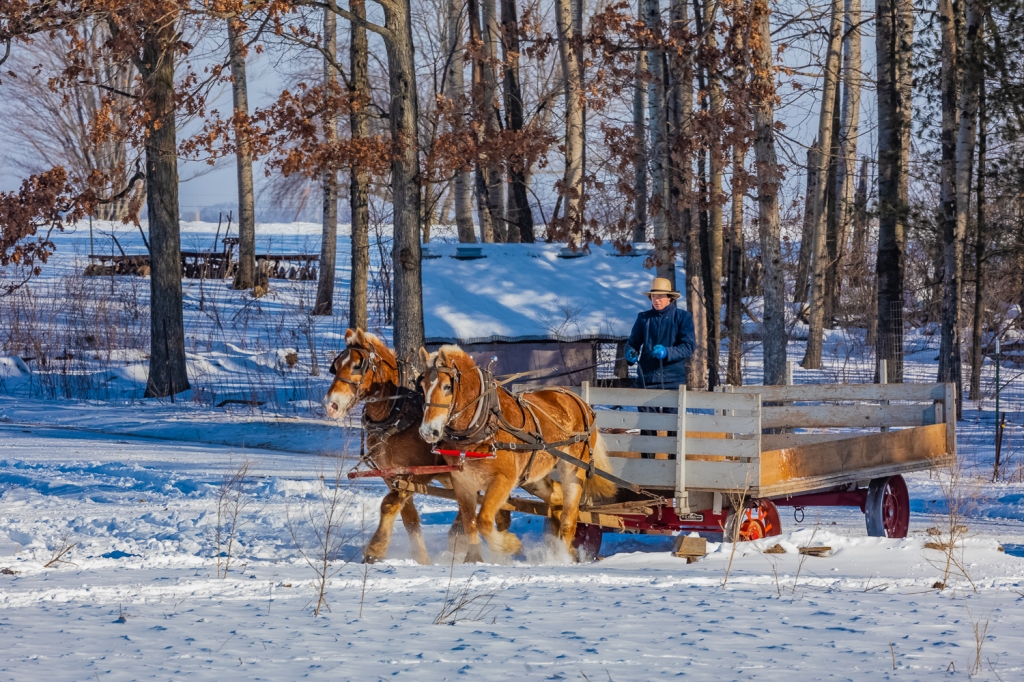
My dear readers, you must be wondering what it’s like to be inside an Amish house; I know we have been curious for years. We finally got our chance when we were invited in for noon dinner. We drove into their driveway and were shy about knocking on the door, in case the Amish wife hadn’t been told of our arrival. After a moment, she appeared at the door with a small son and I walked up to say hello. She said “Will you be joining us for dinner?” So of course I said “yes.”
We went inside, and she escorted us from the entry room, through the dining room/kitchen, to the living room. The living room had a wood-burning stove and the dining table/kitchen area was warmed by the cook stove. The openings between the rooms were large, giving the feel of one big room and also helping to provide even heat to the first floor. We believe that the large room is also used for community church services, but on some farms they use the barn instead of the house. The Amish don’t have a church to go to; instead, they take turns holding services for the nearby community. Every two weeks the community holds Sunday services; each farm hosts for two Sundays, then they rotate to another farm. This family was going to host church services at their home the next day. We have seen Sundays when a farmyard is filled with buggies, perhaps 20 to 30 at a time. Recently we saw children walking home from church, the girls in their black woolen coats, white aprons, and black bonnets, and the boys dressed formally as well.
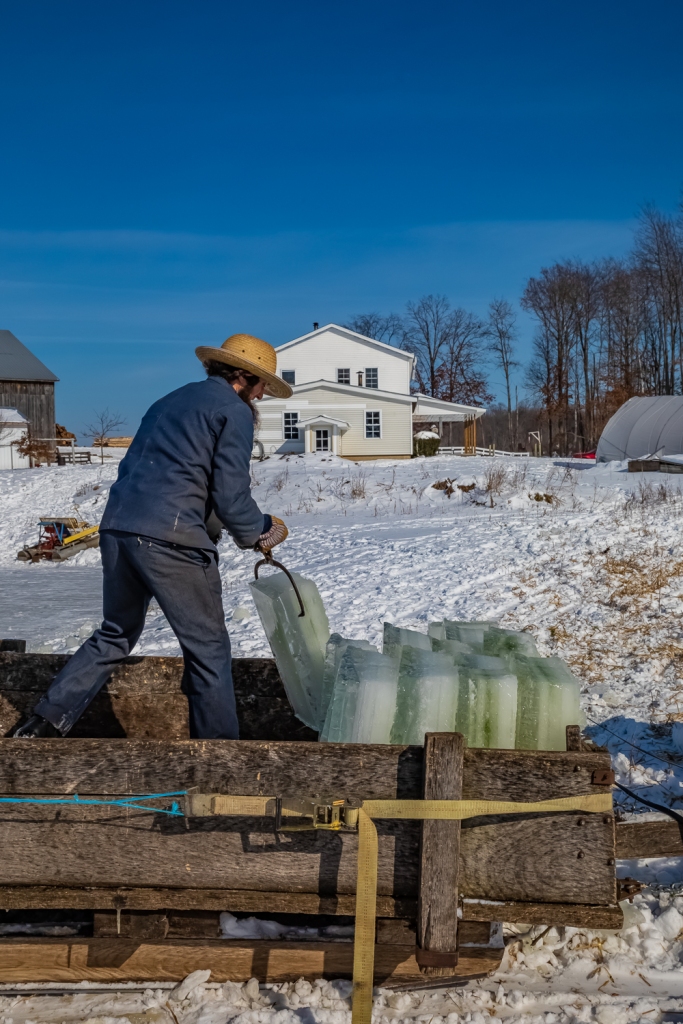
There is no electricity in an Amish home, so natural light during the day and oil or gas lamps at night are the sources of illumination. No televisions or computers, of course. And no plush furniture. Around the perimeter of the living room were wooden rocking chairs, which is where Karen and I sat while waiting for the meal. The youngest boys sat lined up on rocking chairs along one wall, reading long hand-written letters. I didn’t ask who the letters were from, but I could imagine that they could be from the family of their brother who had moved to Illinois and other distant relatives. And, unlike most English children today, they had no problem reading the letters written neatly in cursive!
The house was a comfortable temperature. The lady of the house said she is fortunate that her husband has a sawmill, because there is always plenty of wood to keep their home warm. They cooked on a huge old cast iron wood-burning stove, which also helped heat the house.
There were no family portraits or pictures on the walls, since the Amish don’t wish to have recognizable pictures of themselves, instead believing that humility is to be honored, and individuality and pride are harmful to the community. They follow the Biblical commandment “Though shalt not make unto thyself a graven image.” I took pictures after getting permission from one man and nobody seemed to object, but I was careful to photograph the activity and not the individual. No portraits.
After a few minutes, the Amish wife told us it was time for the meal and indicated two places where we could sit. As you might imagine from the size of the family, the long rectangular table was huge; I think there were 13 of us sitting around it, with the father at the head of the table. Three daughters remained in the kitchen and served the food. When everyone was seated, the Amish father bowed his head; everyone took his cue and bowed their heads as well and all thought a silent prayer for about a minute. Following that, bowls of food were passed.
Dinner was hearty; after all, the men working outside had been cutting and hauling ice, hitching and unhitching teams of huge horses, and lifting heavy blocks of ice into and out of wagons. They were hungry! There were two sets of bowls serving each of the foods because the table was so large. The young men took huge helpings of mashed potatoes and gravy. The meat entree was excellent meatballs and sauce (Karen had to poke me for initially trying to take three meatballs when she noticed that everyone else took two!). There was a bowl of mixed vegetables, a smaller bowl of cabbage salad, and a plate of sliced cheese. After everyone had their fill, two desserts were passed: a chocolate pudding pie and an apple dish that might have been apple crisp. The oldest daughter was the baker.
The young Amish men were curious about our Washington license plates, and we told them we live there most of the year. They asked about Washington state and had heard that part of the state got considerable rain. They wondered why rain and not snow, since it was about the same latitude as Michigan and they seemed to understand when we explained how the influence of the warmer ocean moderates the temperature.
The family enjoyed hearing our story from several years ago of driving an icy road and coming upon a wagon loaded with ice blocks off the road in a ditch. I stopped and asked if I could help. The young man asked me how many horse power I had under the hood of my Subaru and we all laughed. They had another team of horses on the way to help.
They wanted to know where we lived locally and what we did during the day, though what we do is less interesting than what they do! We were at a bit of a loss as to what to say we do, as it didn’t seem appropriate to tell them how much time we spend with our computers or watching television. We asked a lot of questions about their lives and they were pleased to answer. Nice people. I noticed that the school-age children said virtually nothing during the meal (perhaps something about being seen and not heard!). They also all noisily completely cleaned their plates with the sharp sound of silverware striking china. No food was wasted.
After dinner, all bowed their heads again to thank God for the meal. Then everyone disappeared to complete their ice cutting tasks, with the women and girls staying inside to clean up after the meal. In Amish life the roles of men and women are well defined and traditional.
The men had to gather up the horses, who had also been given a break from the harness to feed on hay in the barn, so they all had to be reattached to their sleighs and wagons. We said our thank-yous and goodbyes, pulled on our boots, and went back to our car. I took a few more pictures–actually, the best of the day–and we took our leave. It was an extraordinary experience for us, and it felt like the family enjoyed talking with us, letting us into each other’s lives for a few hours. I bow my head in grace for the time we spent among the Amish.

This article was completed with the kind help of my wife Karen, who contributed immensely to the memories, writing, and editing. To see many of the photographs I’ve taken over a lifetime, go to leerentz.com

